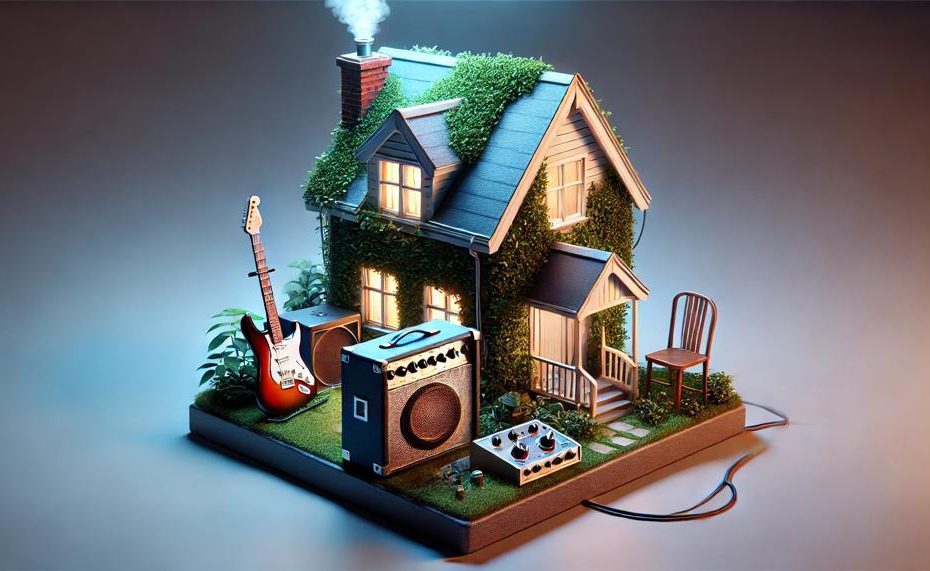Ever wondered how much electricity your home actually uses? To put it simply, most homes operate on an electrical service ranging between 100 and 200 amps. Think of amperage as the volume of electricity flowing through your wires – it’s a critical measure of your home’s electrical capacity.
But this can vary widely: older homes might have as little as 30 amps, while large homes with extensive electric heating can require up to 400 amps.
Here’s what you need to know:
- Typical Range: Most homes use 100 to 200 amps.
- Older Homes: Might only have around 30 amps.
- Large Homes: Can need up to 400 amps, especially with electric heating.
The amount of amps your home uses directly impacts how many appliances and devices you can run simultaneously. Understanding this can help you avoid overloading circuits and ensure a smooth, safe electrical experience. Dive into the fascinating world of home electricity and discover how it powers your daily life.
Contents
How Electrical Current Reaches Your Home
The journey of electricity to your home follows a structured process, impacting the amperage available for household use. Here’s a detailed breakdown:
How Electrical Current Reaches Your Home
- Generation: Electricity is produced at power plants using various energy sources like coal, natural gas, nuclear, hydro, or renewables such as wind and solar. This high-voltage electricity is not suitable for direct household use.
- Transmission: The generated electricity travels long distances through high-voltage transmission lines to reach substations. Transmission lines carry electricity over vast distances, efficiently minimizing energy loss.
- Distribution: At substations, transformers reduce the voltage to safer levels for local distribution. This electricity then travels through a network of power lines to reach your neighbourhood.
- Final Transformation: Another transformer, typically located on a pole near your home or underground, further steps down the voltage to the standard 120/240 volts used by most household appliances.
- Home Connection: The electricity enters your home through the service drop (overhead) or service lateral (underground) into your electric meter. From the meter, it flows to the main service panel, where circuit breakers or fuses distribute it to different circuits in your home.
Impact on Amperage
The main electrical service capacity is crucial as it determines how much electricity your home can safely use at once. Here’s how it works:
- Amperage Defined: Amperage measures the volume of electrical current. The more amps, the greater the electrical load a circuit can handle.
- Common Amperages:
- Older homes: 30-60 amps
- Modern homes: 100-200 amps
- Large homes with extensive electric systems: up to 400 amps
What the Main Service Panel Does
The main service panel determines the amount of amps a house is using by monitoring the electrical load distributed through its individual circuit breakers. Each circuit breaker is connected to specific circuits within the house, allowing the panel to manage and allocate the flow of electricity based on demand.
Inside the main service panel, you will find:
| Component | Description | Function |
| Hot Bus Bars | Two bars carrying 120 volts each | Distribute electricity to circuits for 120 or 240 volts |
| Main Breaker | Central breaker with amp rating (60-200 amps) | Controls all power entering the house |
| Individual Circuit Breakers | Breakers rated 15-50 amps | Control specific branch circuits |
To find out the current usage:
- Measure Each Breaker: Use a clamp meter on each live wire leading from the breaker to see how many amps are flowing.
- Sum the Currents: Add up the measured currents to get the total amps used by the house at any given time.
Fuse Box vs. Circuit Breaker Panel
When examining the distinctions between a fuse box and a circuit breaker panel, safety and functionality stand as the primary areas of divergence.
| Aspect | Fuse Box | Circuit Breaker Panel |
| Overload Protection | Melts and breaks the circuit | Trips and disconnects the circuit |
| Response to Faults | Direct and clear indication (fuse blows) | Swift and resettable (breaker trips) |
| Replacement/Resetting | Requires new fuse | Simply reset the breaker |
| Maintenance | Frequent and cumbersome | Minimal and user-friendly |
| Capacity | Limited, less adaptable | Higher, more flexible |
| Ease of Use | Complex for average users | Simple and convenient |
What You’ll Need
To measure the amps used in a house, you’ll need a few essential tools that ensure accuracy and safety. Here’s a detailed look at what you’ll need and why they’re important:
| Tool | Description | Usage |
| Ammeter | Device that measures the current in a circuit | Connects directly to the circuit to provide precise amperage readings |
| Clamp Meter | Tool that measures current without direct contact | Clamps around a wire to measure the magnetic field produced by the current |
| Multimeter | Versatile tool for measuring voltage, current, and resistance | Includes ammeter functionality for checking household amperage |
| Insulated Gloves | Protective gloves to ensure safety while handling electrical circuits | Worn during measurements to prevent electrical shock |
| User Manual | Guide provided with your measurement tool | Offers step-by-step instructions for accurate and safe use |
Instructions
The necessary steps to properly dispose of items in a household and ensure efficient use of electricity involve a combination of proper disposal practices, awareness of local regulations, and adopting energy-saving habits.
Educate Yourself on Proper Disposal Methods
- Different items have specific disposal requirements. For instance, batteries, light bulbs, and electronics need specialized handling.
- Refer to your local waste management guidelines to know where to take hazardous materials.
Check Local Regulations
- Each municipality has unique rules for disposing of hazardous waste. Understanding these can prevent environmental harm and avoid penalties.
- Local government websites or waste management services often provide detailed disposal instructions.
Dispose of Electronic Devices Properly
- Take electronic devices to authorized e-waste recycling centers.
- These centers ensure safe dismantling and recycling, conserving valuable materials.
Recycle Batteries Separately
- Batteries contain toxic substances and should not be mixed with regular trash.
- Utilize battery recycling programs offered by many retailers and recycling centers.
Reduce Energy Usage
- Switch to energy-efficient appliances and light bulbs. These consume less electricity and reduce energy bills.
- Unplug devices when not in use to avoid standby power consumption.
-
Regular maintenance of appliances ensures they operate efficiently.
This includes cleaning air filters, defrosting refrigerators, and checking for leaks or damages.
Regular Appliance Maintenance
- Keeping appliances clean and well-maintained helps them run more efficiently and use less electricity.
- Routine checks can also extend the lifespan of appliances, reducing the need for replacements.
Tips for Planning Electrical Service Size

Several key factors must be considered when determining the appropriate electrical service size for a house. Here’s a detailed breakdown:
Connected Loads
- Identify and quantify all connected loads, including lighting, appliances, HVAC systems, and other electrical devices.
- Assign amperage values to each item on the list. This helps in understanding the total load demand.
Standardized Service Sizes
- Choose a standardized service size (e.g., 100A, 200A, 400A) based on the calculated demand load. Standard service sizes help in ensuring compatibility and safety.
Professional Consultation
- Consult with a licensed electrical professional to ensure accuracy and compliance with local codes and regulations. This step is crucial for safety and legal compliance.
Property Specifics
- Consider factors such as the type of appliances used (e.g., electric stoves, HVAC systems), the square footage of the property, and diversity factors. Larger homes with more extensive electrical needs will require a higher service size.
Future Expansion
- Plan for future expansions or additions. If there is a possibility of adding more rooms, appliances, or electrical systems, it is wise to account for these in the initial service size calculation.
Code Compliance
- Ensure compliance with the National Electrical Code (NEC) and local building codes. These regulations provide guidelines on minimum service size requirements and safety standards.
Home Age and Existing Infrastructure
- Evaluate the age of the home and the existing electrical infrastructure. Older homes may need an upgrade from 30 amps to 100-200 amps to meet modern electrical demands.
Climate and Heating/Cooling Needs
- Consider the climate and whether the home relies on electric heating or cooling systems. Homes in colder climates with electric heating systems typically require larger service sizes.
Special Equipment
- Identify any special equipment that requires significant power, such as electric vehicles (EVs) or home workshops with heavy machinery.
Conclusion
Understanding your home’s electrical amperage is crucial for a safe and efficient living environment. Typically, modern homes operate on 100 to 200 amps, akin to a high-capacity highway allowing multiple vehicles to travel smoothly without congestion. Older homes might still be running on just 30 amps, while large residences, especially those with extensive electric heating, can require up to 400 amps.
Knowing your home’s amperage ensures you can safely power all your appliances and devices without overloading circuits. This understanding begins with the journey of electricity from generation at power plants to its transmission through high-voltage lines, and finally its distribution to homes. Once the electricity reaches your home, it’s channeled through a main service panel that houses circuit breakers or fuses, regulating the flow and ensuring safety.
In essence, the amperage your home uses is directly tied to its electrical demand and infrastructure. Whether you’re living in a historic home or a modern mansion, understanding and managing your electrical capacity is essential for preventing outages and maintaining a safe, efficient household.





